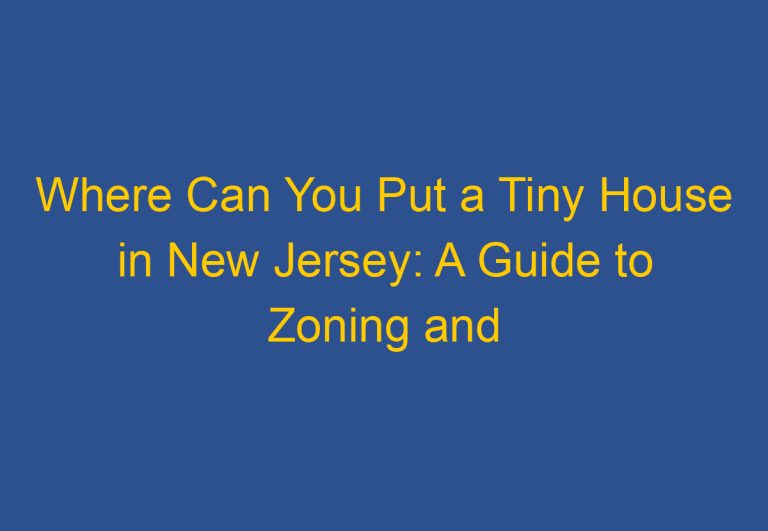Are Tiny Houses Safe in Storms? A Clear and Knowledgeable Analysis
Tiny houses have become a popular housing option for many people due to their affordability and mobility. However, some people have raised concerns about the safety of these houses, particularly during storms. The question on many people’s minds is whether tiny houses are safe in storms.
When it comes to safety, it is important to consider the structural integrity of the tiny house. Tiny houses are built on trailers or wheels, which makes them more vulnerable to severe weather conditions such as hurricanes or tornadoes. Proper anchoring and construction can help to minimize the risk of damage during mild storms.
However, during severe storms, it is advisable to evacuate the tiny house and seek shelter elsewhere. In this article, we will delve into the general safety of tiny houses during storms, explore their ability to withstand extreme weather conditions, and provide tips on how to stay safe in case of a storm.
Design and Construction for Storm Safety
Building Codes and Standards
When designing and constructing a tiny home, it is important to adhere to the building codes and standards set by the local authorities. These codes and standards ensure that the structure of the tiny home is safe and can withstand extreme weather conditions. Building codes and standards cover a wide range of aspects, including foundation, framing, electrical, plumbing, and mechanical systems. It is important to ensure that the tiny home is built to code and that all necessary permits are obtained.
Material Durability and Structural Integrity
The materials used in the construction of a tiny home should be durable and able to withstand extreme weather conditions. The structural integrity of the tiny home is also crucial in ensuring that it can withstand strong winds and heavy rain. The use of high-quality materials, such as steel and concrete, can help improve the durability and structural integrity of the tiny home. Additionally, proper anchoring of the tiny home can also help improve its ability to withstand strong winds.
Weatherproofing Measures
In addition to using durable materials and ensuring structural integrity, weatherproofing measures should also be taken to ensure that the tiny home is safe during storms. This includes proper insulation to prevent heat loss and condensation, as well as the use of weather-resistant materials for the exterior of the tiny home. Proper sealing of windows and doors can also help prevent water from entering the tiny home during storms.
Overall, designing and constructing a tiny home for storm safety requires careful consideration of building codes and standards, material durability, structural integrity, and weatherproofing measures. By taking these factors into account, it is possible to build a tiny home that is safe and can withstand extreme weather conditions.
Risk Management and Preparedness
Preparation and Precautions
When it comes to tiny homes and storms, preparation and precautions are key. Tiny home owners should take steps to ensure that their homes are secure and able to withstand severe weather conditions. This includes anchoring the home to a strong foundation, reinforcing the roof and walls, and installing impact-resistant windows and doors.
In addition to securing the physical structure of the home, tiny home owners should also have a plan in place for evacuation in the event of an emergency. This plan should include identifying a safe location to evacuate to, as well as having a stocked emergency kit on hand.
Insurance and Damage Mitigation
Another important aspect of risk management for tiny homes in storms is insurance and damage mitigation. Tiny home owners should ensure that their home is adequately insured against storm damage, as well as other potential hazards. This may include coverage for wind, hail, and flood damage.
In addition to insurance, tiny home owners should also take steps to mitigate potential damage from storms. This may include trimming trees and other vegetation around the home, as well as securing loose outdoor items that could become dangerous projectiles in high winds.
Regular inspections of the home’s structure and systems can also help to identify and address potential hazards before they become major issues. By taking these steps to prepare and mitigate risk, tiny home owners can help to ensure the safety of themselves and their homes during storms and other severe weather events.
Frequently Asked Questions
How do tiny homes fare against high winds and severe weather conditions?
Tiny homes, when properly anchored and constructed, can be relatively safe during mild storms. However, their small size and lightweight structure make them more vulnerable to severe weather conditions such as hurricanes or tornadoes. High winds can cause damage to the exterior and interior of tiny homes, and severe weather can even knock them off their foundations.
What building standards are in place to ensure the safety of tiny homes during hurricanes?
Tiny homes are built to uphold the same building standards as traditional homes. In some cases, they may even be built to a higher standard. Building codes vary by state, but most require tiny homes to meet certain safety standards, including wind resistance and structural integrity.
Can tiny homes be designed to be hurricane-resistant or storm-proof?
Yes, tiny homes can be designed to be hurricane-resistant or storm-proof. Some builders offer features such as reinforced walls, hurricane straps, and impact-resistant windows to protect against high winds and flying debris.
What are the structural integrity concerns for tiny houses in extreme weather?
The main structural integrity concern for tiny homes in extreme weather is their lightweight construction. Tiny homes are often built on trailers or wheels, which can make them more susceptible to damage during high winds or severe weather. Additionally, the small size of tiny homes can make them more difficult to anchor securely.
How does the safety of tiny homes compare to traditional homes in storm-prone areas?
Tiny homes can be just as safe as traditional homes in storm-prone areas if they are properly constructed and anchored. However, their small size and lightweight construction can make them more vulnerable to damage during severe weather conditions.
What precautions can be taken to protect a tiny home and its occupants during a storm?
There are several precautions that can be taken to protect a tiny home and its occupants during a storm. These include elevating the home or making it flood-resistant, securing the home to its foundation, installing impact-resistant windows and doors, and following evacuation orders if necessary. It is also important to have a plan in place for emergency situations and to stay informed about weather conditions in the area.










